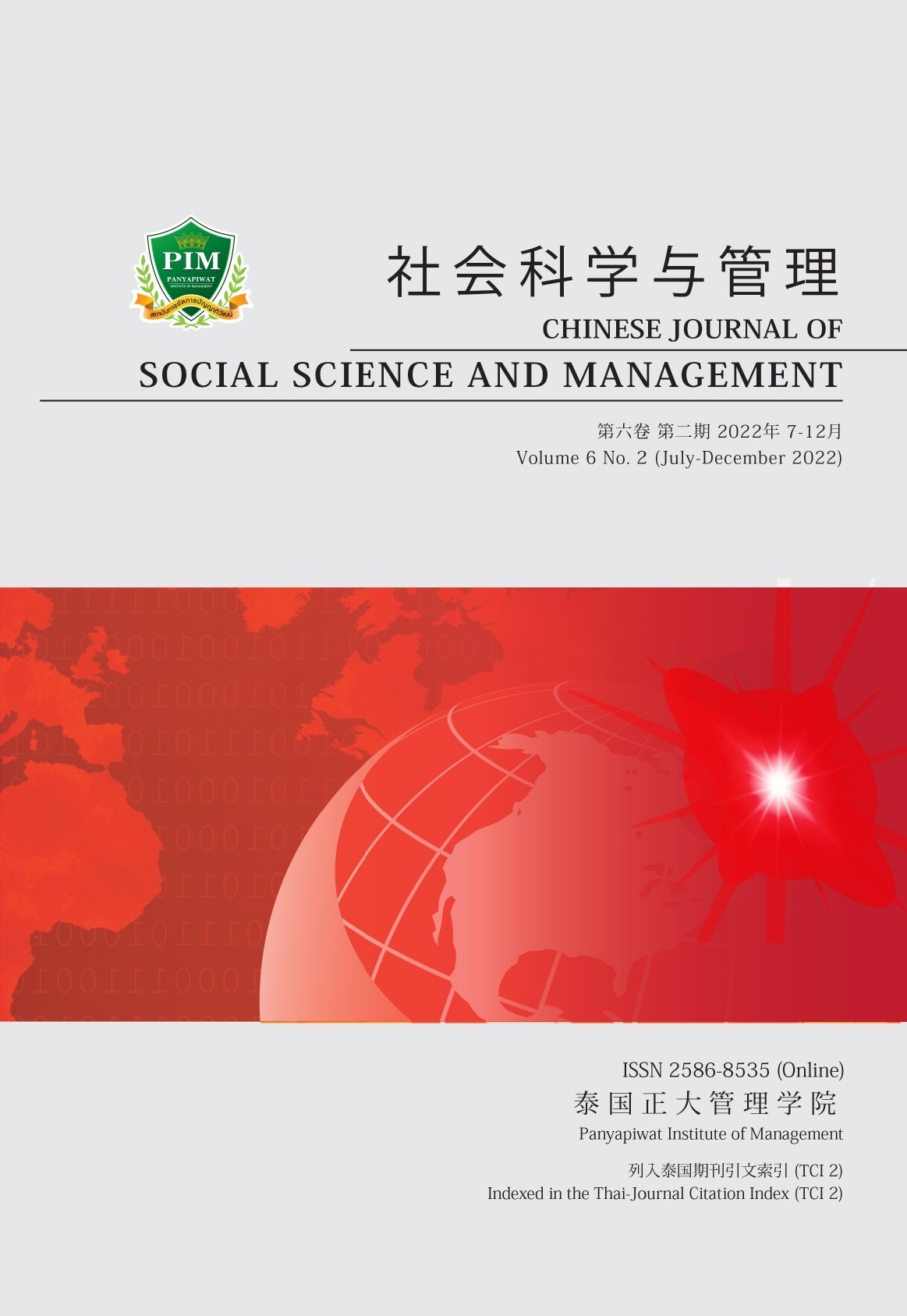THE RELATIONSHIP BETWEEN SOCIAL GENDER CONSCIOUSNESS AND EMPLOYEE PERFORMANCE
Main Article Content
Abstract
As an important social organization, enterprises should pay attention to what kind of influence they will have on employees by strengthening fair and reasonable social gender awareness. This paper constructs the relationship model of social gender awareness, organizational identity and employee work performance, and discusses the moderating effect of corporate cultural strength on organizational identity and employee work performance. It is found that the gender awareness and equality of employees have a significant positive effect on their work performance. Organizational identity plays a part of mediating role between social gender awareness and employee’s work performance. The strength of corporate culture positively moderates the relationship between organizational identity and employee performance. The research conclusions of this paper can not only reveal the gender consciousness as an influencing factor of employee work performance, but also provide a new thinking path for enterprise managers to improve the overall performance of enterprises, and also provide new evidence support and practical inspiration for guiding enterprises to better fulfill their social responsibilities.
Article Details

This work is licensed under a Creative Commons Attribution-NonCommercial-NoDerivatives 4.0 International License.
Chinese Journal of Social Science and Management Editorial Division
The Office of Research and Development, Panyapiwat Institute of Management
85/1 Moo 2, Chaengwattana Rd., Bang Talat, Pakkred, Nonthaburi 11120, Thailand
Tel. 02 855 01048 E-mail: cjssm@pim.ac.th
References
Arvey, R. D., & Murphy, K. R. (1998). Performance evaluation in work settings. Annual Review of Psychology, 49(1), 141-168.
Ashmore, R. D., Deaux, K., & Mclaughlin-Volpe, T. (2004). An organizing framework for collective identity: Articulation and significance of multidimensionality. Psychological Bulletin, 130(1), 80-114.
Bergami, M., & Bagozzi, R. P. (2001). Self-categorization, affective commitment, and group self-esteem as distinct aspects of social identity in the organization. British Journal of Social Psychology, 39(4), 555-577.
Cai, W. C., & Li, C. Y. (2012). The financial strategy which based on maximizing the interests of corporate stakeholders. Business Management Journal, (7), 146-154. [in Chinese]
Chen, L., & Huang, L. (2017). Personality traits, leader identity and motivation to lead: The moderating role of gender. Chinese Journal of Management, (1), 44-54. [in Chinese]
Chen, W. Z., Xin, R., & Wang, A. Y. (2004). A case study of the coordination between enterprise culture and leadership work style. Management World, (2), 76-84, 156-157. [in Chinese]
Cheney, G. (1983). The rhetoric of identification and the study of organizational communication. Quarterly Journal of Speech, 69(5), 143-158.
Dukerich, J. M., Golden, B. R., & Shortell, S. M. (2002). Beauty is in the eye of the beholder: The impact of organizational identification, identity, and image on the cooperative behaviors of physicians. Administrative Science Quarterly, 47(3), 507-533.
Han, X. S. (2007). Research on enterprise organizational identity model based on organizational characteristics. Productivity Research, (23), 117-119. [in Chinese]
Kalin, R., Heusser, C., & Edwards, J. (1982). Cross-national equivalence of a sex-role ideology scale. Journal of Social Psychology, 116, 141-142.
Liu, C., Song, J. W., & Wu, L. Z. (2008). Antecedents of employee career development: An examination of politics and Guanxi. Acta Psychologica Sinica, (2), 79-87. [in Chinese]
Liu, Y. Y., Zhang, J. L., & Liu, Y. M. (2015). An empirical study of moral intensity’s effects on organizational employees’ ethical decision making behavior. Chinese Journal of Management, (8), 1291. [in Chinese]
Luo, N. (2015). The development reviews of research on the antecedents of organizational identification. Jiangsu Commercial Forum, (4), 64-67. [in Chinese]
Mael, F., & Ashforth, B. E. (1992). Alumni and their alma mater: A partial test of the reformulated model of organizational identification. Journal of Organizational Behavior, 13(2), 103-123.
Noddings, N. (2014). Caring a feminine approach to ethics and moral education (2nd ed.). Beijing University Press
O’Reilly, C., & Chatman, J. (1986). Organizational commitment and psychological attachment: The effects of compliance, identification, and internalization on prosocial behavior. Journal of Applied Psychology, 71(3), 492-499.
Riketta, M. (2005). Organizational identification: A meta-analysis. Journal of Vocational Behavior, 66(2), 358-384.
Schumacker, R. E. & Lomax, R. G. (1996). A beginner’s to structural equation modeling. Mahwah, NJ: Lawrence Erlbaum Associates.
Smith, C. A., Organ, D. W., & Near, J. P. (1983). Organizational behavior: Its nature and antecedents. Journal of Applied Psychology, 68(4), 653.
Tsui, A. S., Pearce, J. L., Porter, L. W., & Tripoli, A. M. (1997). Alternative approaches to employee-organization relationship: Does investment in employee pay off? Academy of Management Journal, 40(5), 1089-1121.
Tyler, T. R., & Blader, S. L. (2003). The group engagement model: Procedural justice, social identity, and cooperative behavior. Personality and Social Psychology Review, 7(4), 349-361.
Wang, Y. B., & Dong, P. (2010). Organizational culture integration based on organizational identity--To create an organizational culture atmosphere suitable for human nature. The Journal of Yunnan Administration College, 12(1), 86-89. [in Chinese]
Wood, W., & Eagly, A. H. (2002). A cross-cultural analysis of the behavior of women and men: Implications for the origins of sex differences. Psychological Bulletin, 5(128), 699-727.
Xiong, A. L., Wang, Z. J., Zhang, Y., & Li, H. Y. (2018). Gender heterogeneity and corporate decision: A comparative study from cultural perspectives. Management World, (6), 127-139. [in Chinese]
Xu, W. L., & Zheng, B. X. (2003). Organization recognition and business ethics benefit. Journal of Applied Psychology, 20, 11-138. [in Chinese]
Yan, X. X., Li, C. J., & Zhao, Y. L. (2009). An empirical Study on the relationship between organizational justice and organizational citizenship behavior of employees in enterprises. Modern Management Science, (7), 80-83. [in Chinese]
Yang, C. J., Li, T. R., & Lu, Y. (2014). Organizational ethical climate and voluntary turnover: An empirical study on job embeddedness theory. Chinese Journal of Management, 11(3), 351-359. [in Chinese]
Yang, J. H. (2017). The continuance and change of Chinese people’s gender concept in recent 20 years. Shandong Social Sciences, (11), 62-73. [in Chinese]
Yilmaz, C., & Ergun, E. (2008). Organizational culture and firm effectiveness: An examination of relative effects of culture traits and the balanced culture hypothesis in an emerging economy. Journal of World Business, 43(3), 290-306.


